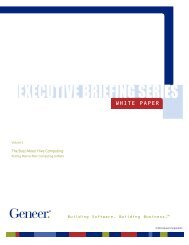Tracing an Internet Email● When an Internet email message is sent, the user typically controls only the recipient lines(s)(To:, Cc:, and Bcc:) and the Subject: line.● Mail software adds the rest of the header in<strong>for</strong>mation as it is processed.● Typically, only the From:, To:, Subject:, and Date: lines are displayed. The setting to view thefull or extended header in<strong>for</strong>mation is usually found in the Options or Preferences menu of the e-mail software.● The full or extended email header will contain in<strong>for</strong>mation useful in tracing the message back tothe source. Internet Protocol (IP) addresses and assigned message id numbers along with the timeand date stamps are integral in tracing the origin of a message, verifying the in<strong>for</strong>mation in theFrom: line is correct or authenticating the transmission in<strong>for</strong>mation <strong>for</strong> the message.● Header in<strong>for</strong>mation will vary depending on the type of mail system used and mail servers usedto process the messages.Email header:In this example, the From: line suggests the sender is polaris99992001@yahoo.com. The"polaris99992001" is the name of the mailbox located at the "Yahoo" mail server location. The To:line indicates the recipient is johndoe83721z@hotmail.com. The Date: line indicates the date andtime the message was submitted to a Yahoo mail server. Date and time stamps are only as reliableas the clock setting on the computers that process the message.The extended header in<strong>for</strong>mation is usually read from bottom to top. The Message ID is a uniquenumber assigned to the email as it is processed by a server and may be useful in determining if themail is a <strong>for</strong>gery by comparing the ID with logs retained by the server that issued the ID. The nextline states the message is from polaris99992001@yahoo.com. The lines beginning with Received:in the extended email header are created as the message traverses mail servers. In<strong>for</strong>mation in theReceived: lines varies depending on the mail server and software processing the message. The firstReceived: line in this example states- Received: from [12.26.159.122] byweb20808.mail.yahoo.com via HTTP and is data/time stamped. This first Received: line can bevaluable in this case to identify what computer or network was involved in transmitting the
message to yahoo.com <strong>for</strong> processing. The next Received: line states – Received: from[216.136.226.197] by hotmail.com and contains an ID number and date/time stamp from theHotmail mail server. The IP address, domain name, or server name can usually be associated withthe following:Numerous services provide a web Whoisinterface to research IP address in<strong>for</strong>mation suchas the American Registry <strong>for</strong> Internet Numbers(www.arin.net). An Internet search <strong>for</strong> nslookupwill also provide several web interfaces toresearch the server names.A Whois lookup on 12.26.159.122 reveals the IP address is associated with AT&T (ISP) andPricewaterhouseCoopers (customer). Contact in<strong>for</strong>mation can be obtained by clicking on the links.Overall, this example indicates a computer located on the PricewaterhouseCoopers’ network causeda message to be sent through the AT&T ISP network to a Yahoo email server which finallyprocessed the message to a user’s mailbox on the Hotmail email server.In addition to looking up an IP address to identify a network/contact <strong>for</strong> investigation, aninvestigator can also look up a domain name using similartools. For example, by visiting the same site www.arin.net, auser can type in the name of a domain, i.e. Hotmail andreceive the contact/technical in<strong>for</strong>mation necessary to furtherthe investigation.The contact listed may not be the best person to handle callsconcerning a subpoena, court order or search warrant. But itprovides a lead to identify theappropriate person. An additionalresource is Infobin.org(www.infobin.org), which containscontact in<strong>for</strong>mation relevant to aninvestigator <strong>for</strong> most of the ISP’s.ISP’s and email service providersstore data useful in identifying thesender of the email, such assubscriber in<strong>for</strong>mation, billingSearch <strong>for</strong>: hotmailHotmail Corporation (NETBLK-NETBLK-HOTMAIL)1290 Oakmead Parkway, Suite 218Sunnyvale, CA 94086USNetname: NETBLK-HOTMAILNetblock: 207.44.165.64 - 207.44.165.127Coordinator:Delucchi, Randy (RD3101-ARIN) rdelucchi@HOTMAIL.COM408-222-7037 (FAX) 208-222-7020Record last updated on 26-Nov-1997DataBase last updated on 25-Sep-2001 23:16:15 EDT.in<strong>for</strong>mation, and connection logs, which contain the IP addresses and date/time stamps used toconnect to the ISP. The IP address may reveal the sender’s ISP or employer, as in this example, thesender is using the service from work. In some cases, if the sender is using a modem and phoneline, an Internet backbone company can use the connection in<strong>for</strong>mation, provided by the ISP or e-mail service provider, to obtain the Automatic Number Identification (telephone number) of thephone line used to dial into the ISP.There are many resources on the web that discuss email headers, includinghttp://help.mindspring.com/docs/006/emailheaders/and http://www.stopspam.org/email/headers/headers.html.Submit Query



